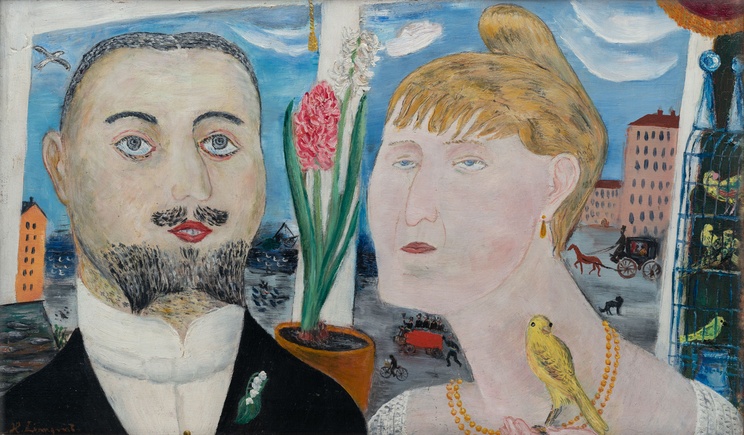His 1916 debut at Liljevalchs garnered a slew of bad reviews. Hilding Linnqvist responded to the criticism with total silence. Within a few years he was acclaimed as one of his time’s greatest painters. Soon, the critics celebrated him and referred to him as Hilding Linnqvist, the naïvist and hailed him as the most prominent precursor and spearhead of the movement.
Interiors and landscapes were clad in the garb of imagination and poetry. The outside world was adorned with love metaphors, a search for the perfection of the body and the soul, the cautious pleasures and the alchemy of eroticism and religious speculation. The acts and performances were played out in painting after painting as different chapters: Hjärtats sång[Song of the Heart], Drottningens juvelsmycke [The Queen’s Tiara], De lyckliga människorna [The Happy People], Lustgården [The Garden of Eden], Sommaren [The Summer], I tysta kvällen [In the Quiet Evening], Smycken och kristall [Jewellery and Crystals], and Den gamla parken [The Old Park].
The protagonist, in addition to being Hilding Linnqvist’s alter ego, was also Carl Jonas Love Almqvist’s celestial being, the androgynous Tintomara. Like a wondrous cicerone, Hilding Linnqvist elevated his painting out of the quotidian. The reasons and choices for becoming an artist were heightened by the neo-romantics’ passionate search for the gold of the soul. The essayist and critic Ulf Linde described Hilding Linnqvist’s painting as style-less, in the best sense of the word, explorative in each brushstroke. The duplicity of infatuation and love was also amusing for a 1910s rogue like Marcel Duchamp. The artist’s role as we know it today is still upheld by the love metaphor. Poets, from Stagnelius and Almqvist to Fröding and Ekelund, were a source of inspiration for Hilding Linnqvist. The poets among the critics of the time found in him a special friend.
In 1916, the 25-year-old Hilding Linnqvist made his debut at Liljevalchs, as one of the up-and-coming names in only the third exhibition held at the Gallery. The Autumn Salons and the salons for the young eventually found their form in the middle of the 1920s and are currently known as the traditional Spring Salon. Prior to this, Hilding Linnqvist had participated in six, for him, important exhibitions all of which paved the way for the creation of his well-established art practice.
A book about Hilding Linnqvist’s early years will be published in conjunction with the exhibition, featuring texts by the artist and the book’s editor Susanna Slöör, essayist Ulf Linde and curator Annika Gunnarsson, Ph.D.
Gallery name: Liljevalchs
Address: Djurgårdsvägen 60, Stockholm
Opening hours: Mon-Sun 10:00 - 18:00
Open: 09.10.2020 - 21.03.2021







